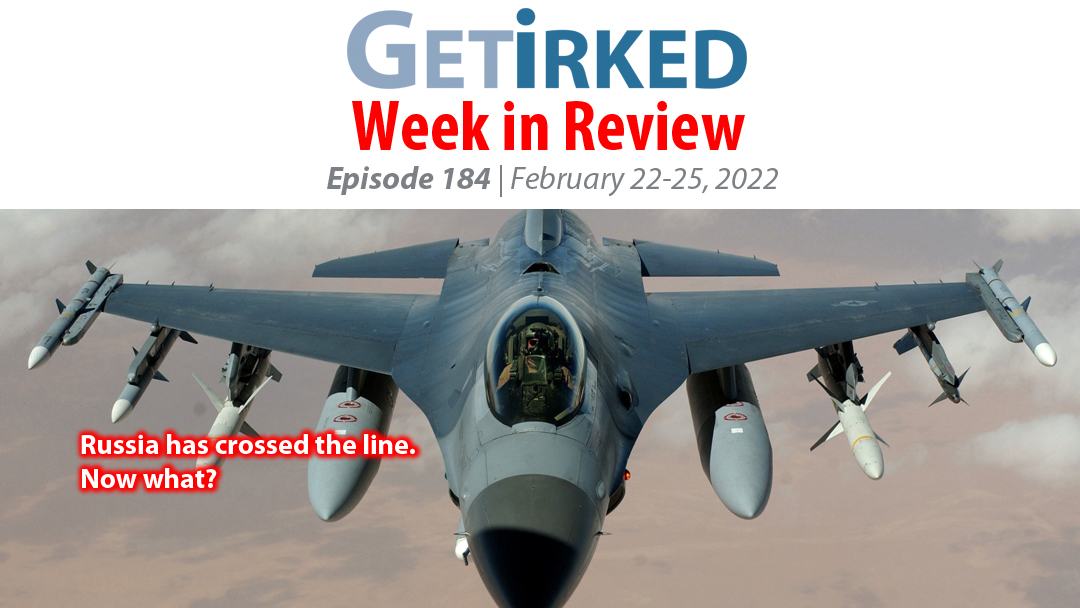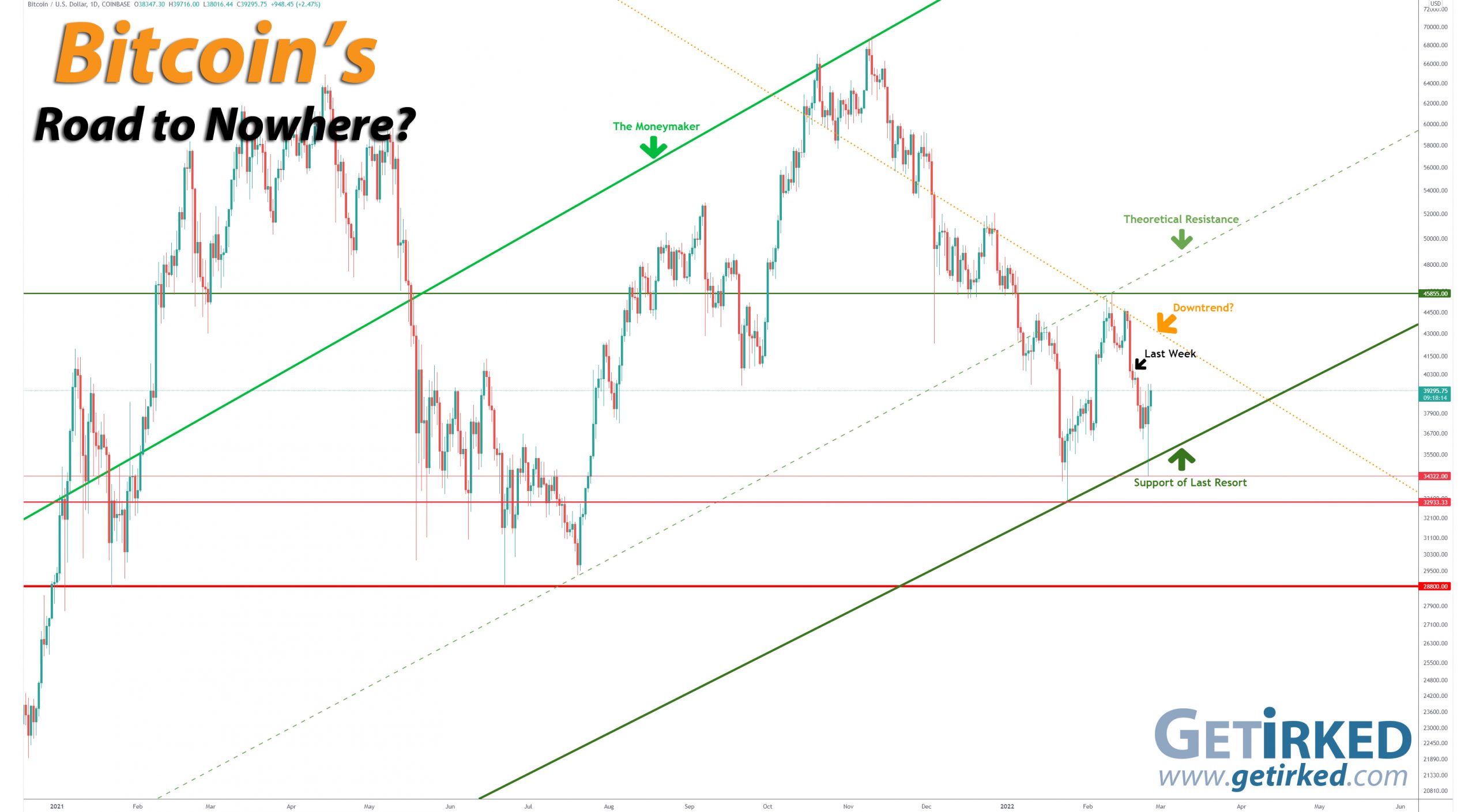Summing Up The Week
The heated debate and political climate we’re in now precipitates the need to say that which should not need to be said – war is abhorrent. War is evil. Russia’s invasion of Ukraine, a democratically-elected government of free people, is irreprehensible. My heart goes out to those who are impacted by the atrocious acts of Vladimir Putin and his lackeys.
However, this is a newsletter about the stock market. Unfortunately (or fortunately, perhaps), the stock market does not exhibit emotion. The stock market does not care what’s going on with humans’ lives; it simply reacts. My goal for Get Irked has always been to teach others how to invest for the long-term and how to manage volatility in the markets.
While I vigorously disagree with the actions taken by Russia, I will strive to keep my personal perspectives out of the meat of this weekly newsletter.
With that, let’s look at what happened in the markets this week…
Market News
Russia invades Ukraine
The entire market sold off dramatically throughout the week in anticipation of a potential invasion of Ukraine by Russian, and this selling reached a fever pitch after Russia invaded Ukraine Wednesday evening, reported CNBC.
According to his own writings and essays, Russian President Vladimir Putin has long-declared a desire to reincorporate all of Ukraine with the rest of Russia, claiming that Ukraine has always been a part of the Soviet Union and should never have been split off into its own country.
Additionally, Putin expressed concerns that Ukraine may join the North American Treaty Organization (NATO), an event he states would be akin to Canada or Mexico allying with China against the United States.
Geopolitical unrest is never a good thing for the markets, and outright conflict is, naturally, much worse. As a result, the majority of stocks sold off except for oil and precious metals which tend to outperform during global strife.
While there may have been other news stories in the markets this week, none affected the direction of the markets to any magnitude relative to the war in Ukraine.
On Thursday, the stock market sold off precipitously to start the day before bouncing incredibly throughout the remainder of the day with indexes not only recouping losses, but posting gains relative to the previous day. Pundits attempted to explain the bounce as investors discounting a potential outcome that the Fed would no longer raise rates in March as geopolitical tensions causes global money to shift into bonds.
China refuses to call Russian attack an “invasion”
On Thursday, China’s Foreign Ministry spokesperson refused to describe the Russian invasion of Ukraine as an “invasion,” reported CNBC. In fact, the spokesperson went on to blame the U.S. for the attack, claiming “the U.S. has been fueling the flame, fanning up the flame, how do they want to put out the fire?”
To the uninitiated, China’s response may not seem of much significance, however, the country’s careful language could underlie a darker potential – China plans to invade Taiwan and wants Russian support when it does. China has refused to acknowledge Taiwan’s independence as its own country, continually reiterating that Taiwan is simply part of the China motherland and expressing intentions to reunify with Taiwan.
Over the past several years, experts believe this rhetoric has been reaching a fever pitch, perhaps an indication that China is currently planning its own invasion of a neighboring country it believes to be part of the republic.
Fed’s favorite inflation figure shot up 5.2% in January
On Friday, the Commerce Department reported that Personal Core Expenditures (PCE), the Federal Reserve’s preferred figure for inflation, skyrocketed 5.2% year-over-year in January, slightly more than the 5.1% Dow Jones estimate, reported CNBC.
The index includes food and energy, and headline PCE was up 6.1%, the biggest gain since February 1982 when inflation was out of control. As a result, despite the recent war in Ukraine, the Fed likely must continue on its path of tapering and raising the benchmark interest rate at its upcoming meeting in March.
Despite this objectively negative news, the markets continued to bounce off of their remarkable bottom on Thursday.
Next Week’s Gameplan
While the threat of war typically causes the stock market to sell off, when war actually breaks out, the markets historically rebound. The whole thought of wartime not having a negative impact on the movement of investments may seem counter-intuitive, however, it’s important to remember that the stock market is a forward-predicting instrument; in other words, it looks through present events to discount what might happen in the future.
Regardless, in times like these, it’s important to keep your head on straight and not allow the market’s gyrations to affect your emotions. As I’ve said before, if you can’t handle the extreme volatility, it’s best not to look at your portfolios at all. There are far more important things in this life than our stock positions.
With that said, I hope you all stay safe and stay warm. I’ll see you next week.
This Week in Play
Stay tuned for this week’s episodes of my two portfolios Investments in Play and Speculation in Play coming online later this weekend!
Crytpo Corner
Important Disclaimer
Get Irked contributors are not professional advisers. Discussions of positions should not be taken as recommendations to buy or sell. All investments carry risk and all readers must accept their own risks. Get Irked recommends anyone interested in investing or trading any asset class consult with a professional investment adviser to determine if an investment idea is suitable to them and their investment goals.Bitcoin Price (in USD)
%
Weekly Change
Bitcoin Price Action
Bitcoin blows up… again.
Bitcoin lost all support along with the rest of the risk assets after Russia invaded Ukraine Wednesday. With gold continuing its meteoric rise, Bitcoin and the rest of the crypto sector must permanently give up the “Digital Gold” thesis that so many crypto bulls have been touting for years – Bitcoin is a risk instrument, not one of wealth preservation.
All previous support except for the low of the current bear trend gave up. Bitcoin didn’t find support until bouncing off $34,322.00 on Thursday. The Support of Last Resort trendline may have offered Bitcoin some solace, however, it’s important to remember that this very trendline has been broken before in both 2020 and 2018.
The current bear trend low of $32,933.33 marks the line in the sand for Bitcoin; if that support doesn’t hold, the crypto’s looking at the $28,800.00 low from June 2021, and then there’s very little between that low and the $20,000 price target the bears keep pointing to.
The Bullish Case
Bulls have to step back and lick their wounds this week. Bitcoin obviously isn’t holding support and there’s no sign of this macro bear move ending any time soon. Even the most pro-Bitcoin pundits like Michael Saylor, CEO of MicroStrategy (MSTR) sound disingenuous, at best, trying to talk up their own holdings as fear starts to set in about how low this current bear run could go.
The Bearish Case
With the digital gold thesis destroyed and news events causing all risk assets to sell off, the Bears will continue to dominate the thesis for Bitcoin for the time being. With no diplomacy resolving the Russian invasion and the Fed’s upcoming rate hikes about to begin, there is seemingly never-ending ammunition for the bear case against Bitcoin’s potential to reverse the current downtrend.
Bitcoin Trade Update
Current Allocation: 5.639% (+0.263% from last update)
Current Per-Coin Price: $41,778.34 (-0.560% from last update)
Current Profit/Loss Status: -5.942% (-0.841% from last update)
I added throughout the selloff, earning an average buying price of $36,997.48 across a number of small buys I made since my last update. My orders locked in an -18.177% discount on the Bitcoin I sold last week at $45,216.44 and lowered my per-coin cost -0.560% from $42,013.81 to $41,778.34.
The buys also raised my allocation +0.263% from 5.376% to 5.639%. Despite executing nearly a half dozen buy orders, my quantities continue to remain small as Bitcoin still hasn’t sold off enough to trigger any of my larger-quantity buys. However, we are getting much, much closer…
My current per-coin price represents a -35.753% reduction from this trade’s initial starting price of $65,027.96 thanks to Buying in Stages.
Bitcoin Buying Targets
Using Moving Averages and supporting trend-lines as guides, here is my plan for my next ten (10) buying quantities and prices:
0.272% @ $34,486
0.550% @ $33,858
2.562% $ $31,229
3.340% @ $27,255
6.142% @ $23,929
6.648% @ $21,818
10.36% @ $19,610
2.382% @ $15,456
4.548% @ $12,655
4.548% @ $10,709
No price target is unrealistic in the cryptocurrency space – Bullish or Bearish.
While traditional stock market investors and traders may think the price targets in the cryptocurrency space are outlandish due to the incredible spread (sometimes a drop of near -90% or a gain of up to +1000% or more), Bitcoin has demonstrated that, more than any speculative asset, its price is capable of doing anything. Here are some of Bitcoin’s price movements over the past couple of years:- In 2017, Bitcoin rose +2,707% from its January low of $734.64 to make an all-time high of $19,891.99 in December.
- Then, Bitcoin crashed nearly -85% from its high to a December 2018 low of $3128.89. In the first half of 2019, Bitcoin rallied +343% to $13,868.44.
- From June 2019, Bitcoin crashed -54% to a low of $6430.00 in December 2019.
- From December 2019’s low, Bitcoin rallied +64% to $10,522.51 in February 2020.
- In March 2020, Bitcoin crashed nearly -63% to a low of $3858.00, mostly in 24 hours.
- Then, Bitcoin rallied +988% to a new all-time high of $41,986.37 in January 2021.
- Later in January, Bitcoin dropped -32% to a low of $28,732.00.
- In February 2021, Bitcoin rallied +103% to a new all-time high of $58,367.00.
- Later in February, Bitcoin dropped -26% to a low of $43,016.00.
- In April 2021, Bitcoin rallied +51% to a new all-time high of $64,896.75.
- In June 2021, Bitcoin crashed -56% to a low of $28,800.00.
- In November 2021, Bitcoin rallied +140% to a new all-time high of $69,000.00.
- In January 2022, Bitcoin crashed -52% to a low of $32,933.33.
What if Bitcoin’s headed to zero?
The only reason I speculate in the cryptocurrency space is I truly believe Bitcoin isn’t headed to zero. I am prepared for that possibility, however, by knowing I could potentially lose all of the capital I’ve allocated to this speculative investment. Professional advisers recommend speculating with no more than 5% of an investor’s overall assets. Personally, I’ve allocated less than that to speculating in crypto. I feel that anyone who doesn’t fully believe in the long-term viability of cryptocurrency would be better served not speculating in the space. On a good day, this asset class isn’t suitable for those with weak stomachs. On volatile days, the sector can induce nausea in the most iron-willed speculator. If a speculator isn’t confident in the space, the moves will cause mistakes to be made.


